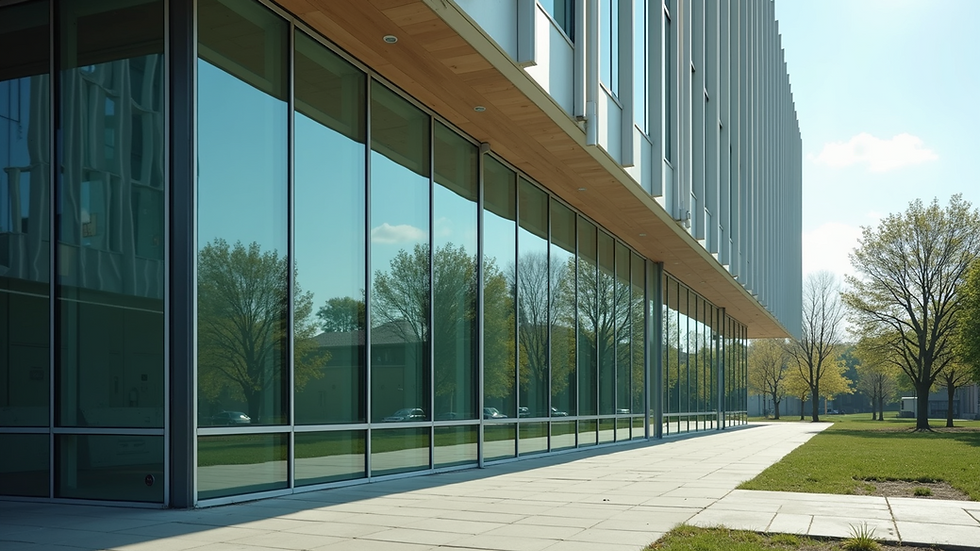Unveiling the Benefits of Eco-Friendly Window Tint for Sustainable Energy Savings
- Londonwindowtint
- Mar 19
- 3 min read
Updated: Aug 11
In today's world, where sustainability is crucial, finding effective ways to lower energy consumption has never been more urgent. One often overlooked solution is eco-friendly window tint. This post will explore the numerous benefits of window tint for energy savings, showing how sustainable window tints can pave the way for a greener future.
Understanding Window Tint for Energy Saving
Eco-friendly window tint is expertly crafted to reduce heat gain and glare, allowing natural light to fill a space without the accompanying discomfort. Unlike traditional window films that may contain harmful chemicals, sustainable window tints focus on using materials that are less damaging to the environment. For instance, many eco-friendly options utilize recycled materials, which reduces waste and energy used in production. Not only do these tints enhance the visual appeal of buildings, but they also play a significant role in energy conservation.
The primary role of window tint in energy savings is to help regulate indoor temperatures. Research shows that quality window tints can reflect up to 80% of solar energy. By doing so, these tints maintain a comfortable indoor climate without heavily relying on air conditioning. This not only helps save energy but can cut utility bills by as much as 15-20%, benefiting both homeowners and businesses alike.
The Environmental Impact of Window Tinting
The environmental advantages of energy-saving tints go beyond just personal savings. Reducing the demand for energy decreases greenhouse gas emissions significantly. For example, studies reveal that energy-efficient window treatments can reduce a household's carbon footprint by up to 1,000 pounds per year. In urban areas, where energy demands can soar, improving energy efficiency is crucial for enhancing air quality.
Additionally, many eco-friendly window tints are produced through eco-conscious methods. This means less waste and fewer harmful byproducts during manufacturing. By choosing these sustainable options, consumers voluntarily support businesses that prioritize environmental responsibilities, encouraging more companies to turn towards greener practices.
Enhancing Comfort and Aesthetics
Beyond energy savings, eco-friendly window tints transform the comfort and aesthetics of any environment. By minimizing glare, these tints foster a more enjoyable atmosphere for occupants, whether they are at home, in a school, or visiting a public space. For example, students studying under the glare of direct sunlight can be easily distracted, but with the right tint, they can focus better and improve their learning outcomes.
Moreover, sustainable window tints are available in many styles and shades. This allows property owners to select choices that perfectly match their design tastes. This flexibility ensures that energy-saving tints can blend seamlessly into any architectural style, upgrading aesthetic appeal for both the interior and exterior of a building.

Cost-Effectiveness of Sustainable Window Tints
Investing in eco-friendly window tint can yield notable savings in the long run. While the upfront costs may be higher compared to traditional window films, the subsequent decrease in energy expenses more than compensates for this initial investment. Many homeowners report reductions in their energy bills ranging from 10% to 30% after they have installed energy-saving tinting.
Furthermore, various regions provide incentives or rebates for energy-efficient enhancements, including window tinting. These financial benefits can further lower the total cost of installation, making eco-friendly options even more appealing for individuals aiming to improve their property's energy efficiency.
Selecting the Right Window Tint
When choosing a sustainable window tint, consider essential factors such as heat rejection rate, UV protection levels, and overall design appeal. Not all window tints are equivalent; understanding your unique requirements can guide you towards the best product for your space.
Seeking advice from professionals in window tinting can provide helpful insights tailored to your property. They can evaluate your needs and recommend products that not only meet your specific comfort requirements but also align with your sustainability goals.
Moving Towards a Greener Future
Eco-friendly window tint stands as a valuable ally in the pursuit of sustainable energy savings. By minimizing heat gain, decreasing energy bills, and fostering environmentally responsible manufacturing practices, these tints deliver substantial benefits for both homeowners and our planet.
As we strive for innovative solutions to address climate change, incorporating sustainable window tints is a meaningful step. By making thoughtful choices and investing in energy-saving tinting, we can support a greener future while enjoying the comfort and visual appeal of our living spaces.





If you're in Orange County and looking to experience these secret sustainable superpowers firsthand, I highly recommend checking out OC Tint Solutions. They're certified professionals with years of hands-on experience in both automotive and residential tinting. Best of all, they’re available 24/7, offer upfront pricing, and use premium-grade films that combine performance with eco-efficiency. Whether you’re a homeowner, business owner, or daily commuter, they make the entire process seamless and results-driven.